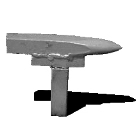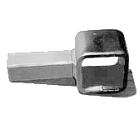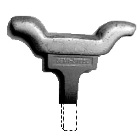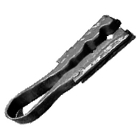| |
 |
 |
 |
 |
 |

Figure 1 |
1" sq stock, forged to a point and cleaned up on the belt grinder. It has a spacer welded below the bic to get it above the anvil table, then a hardy shank welded below.
The 1" (24mm) square end I use on hinges, see the bean hinge demo. . . the bic point is very useful for small rings and small diameter radiuses.
|
 |
 |

Figure 2 |
This saddle anvil is made from heavy wall 2" sq tubing. I made this with a 2" wide cut of a long tube, then beveled the sides slightly with a side winder grinder.
It is particularly useful for forging a top piece that wont have room between it and the bottom piece to work over the anvil...such as a three prong fork, after it has already been formed into the form.
|
 |
 |

Figure 3 |
This is a leaf veining tool made from a large tractor bolt.
I forged the hardy tenon down to size, then made an oblong of the bolt head, then dropped it into the hardy hole to forge the top a bit convex.
I then polished the convex face, and reheated for putting in the veining work with a chesil. Then repolished, and heat treated.
|
 |
J-J
|
 |
This tool is a quick way to make a forged leaf look more realistic, especially when you work by yourself.
As a hint for leaf making, tap a large threaded screw into the edges of the leaf (leaf held in the vice) before veining for an added touch.
|
 |
 |

Figure 4 |
This is another type of saddle anvil. For those of you familiar with copper work, you'll recognize this from most any copper how-to book.
The fellow i got this from says the design came from Dorothy Steigler and that it is one of her most favorite tools for flower making.
|
 |
J-J
|
 |
Make it from a 1 1/4" square stock about 10 inches long. Forge so that it is 1" high and 1 1/2" wide, then bevel the ends down a bit and forge to shape, before welding on the hardy tenon.
|
 |
 |

Figure 5 |
This is a tool i got from Donald Streeter. It's a vice clamp for round stock.
This vice clamp is forged from about 12" of 3/4" sq or 5/8" and made a bid thinner from the top and that makes it a bit wider, from a side or end view, giving more bite once clamped into the vice.
|
 |
 |

Figure 6 |
(End View) I leave about five inches at about 1/2" x 1" and then thin the inner section down to form a spring clamp, then i weld on a 1/8" sq piece to the side aligning with the top. This keeps it from falling out of
the vice when the vice is opened.
This is used for delicate round stock forgeings that you do not want marred up with the flat vice jaws. A very firm holding tool.
|
 |
 |

Figure 7 |
Lots of time we need to make heads on something. This heading block with several sized holes drilled in and hardened/tempered is just the ticket. A spacer below is used at times or just sit it over the pritchel hole once the head is formed enough to hold in place.
|
 |
J-J
|
 |
These are some of the tools that i used to help me jump from beginning projects to more intermediate projects. I still use them on a regular basis in my shop.
|
 |
J-J
|
 |
Any questions folks?
|
 |
BARNE
|
 |
Spring steel used for the hinge part of the round stock clamp
|
 |
J-J
|
 |
No Barne, it's just mild steel all the way.
|
 |
TOM STOVALL
|
 |
JJ, on your veining tool, why don't the veins extend all the way to the periphery of the tool's head?
|
 |
J-J
|
 |
The leafs aren't that big i use this for Tom. On really large leaves, I use a curved chisel and work under the treadle hammer.
|
 |
STEVE-C
|
 |
JJ on the jig for holding the round stock, are the edges beveled some to keep from marring the steel?
|
 |
J-J
|
 |
Steve, very good point. Yes, the edges of the vice clamp are beveled with a grinder. I should have said how i make the holes. Sometimes i just forge them, othertimes, I've clamped the pieces into a drill press clamp and drilled them.
|
 |
BBB
|
 |
On the bick, a bull pin (or Spud Wrench), used to align holes for assembling big iron, available from flea market, makes it easy
|
 |

